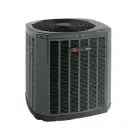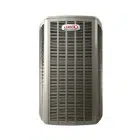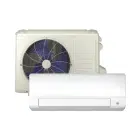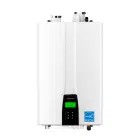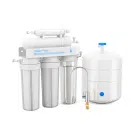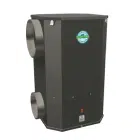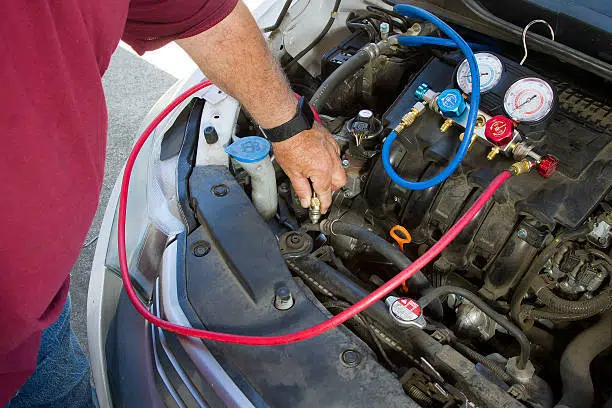
Table of Contents
- Step 1: Turn Off Your AC Immediately
- Step 2: Check and Replace Your Air Filter
- Step 3: Inspect for Refrigerant Leaks and Low Pressure
- Step 4: Make Sure the Blower Motor and Fan Are Working
- Step 5: Schedule Professional Coil Cleaning and System Maintenance
- How Much Does It Cost to Fix a Frozen AC Coil?
- FAQs
A frozen air conditioner coil can throw your entire cooling system out of whack — and often at the worst possible time. In this guide, we’ll take a deep dive into how to fix a frozen AC coil properly, what causes it in the first place, and what you should absolutely avoid doing to prevent long-term damage to your HVAC system.
Step 1: Turn Off Your AC Immediately
The very first thing you should do when you discover your AC coil is frozen is turn off the system completely. Continuing to run your AC while the evaporator coil is encased in ice can lead to compressor failure, refrigerant backflow, or a burnt-out motor — all of which can be expensive to repair.
After shutting the system down, switch the thermostat to the “Fan” setting. This helps warm air circulate through the system and can speed up the thawing process. Don’t try to scrape or chip away the ice manually — this can damage the coil fins or even puncture the tubing, causing refrigerant to leak.
Depending on how severely the coil is frozen, it can take anywhere from a few hours to overnight for the ice to fully melt. If you want to understand how to fix frozen AC coil issues for good, you need to let the system thaw completely before attempting any diagnostics or repairs.
While waiting, it’s a good idea to check the surrounding area for signs of water pooling. Condensation from the thaw may overflow the drain pan and cause water damage. Place towels or a shallow pan under the unit to catch any drips, especially if it’s located in an attic or above finished ceilings.
Step 2: Check and Replace Your Air Filter
One of the top reasons AC coils freeze is restricted airflow, and in many cases, the culprit is a dirty or clogged air filter. A filter that’s full of dust, pet hair, or debris can significantly reduce the volume of warm air passing over the evaporator coil. Without enough heat to absorb, the refrigerant inside the coil becomes too cold and starts to freeze moisture from the air onto the coil’s surface.
If you’re wondering how to fix frozen AC coil problems without calling a technician right away, start by removing your current air filter and holding it up to the light. If you can’t see light passing through it, it’s time to replace it. Choose the right MERV rating for your system — usually between 8 and 13 for residential use — to balance air quality and airflow.
Make sure the filter is installed facing the correct direction (arrows should point toward the blower motor). Then, once the ice is completely thawed, you can restart the system and observe whether the problem comes back.
Also take the time to inspect any return vents or registers throughout your home. Make sure they’re not blocked by furniture, rugs, or closed completely — airflow obstructions at any point in the system can contribute to frozen coils.
Remember: if you’re regularly asking yourself how to fix frozen AC coil issues, changing your filter more frequently (every 30–60 days during peak use) can often prevent the problem altogether.
Need a professional duct cleaning in your area? Contact HVAC Service Solutions via the link below.
Step 3: Inspect for Refrigerant Leaks and Low Pressure
If the air filter is clean and airflow is normal, the next most likely cause of a frozen coil is low refrigerant levels. When refrigerant is low, pressure inside the evaporator coil drops — causing it to get colder than it should. This results in freezing, even if the rest of the system is functioning correctly.
Unfortunately, this isn’t a fix you can DIY. Refrigerant doesn’t get “used up” — if your system is low, it almost certainly has a leak. And because refrigerant is a hazardous substance, only a certified HVAC technician can legally and safely handle a recharge.
To check whether low refrigerant might be your issue, listen for hissing sounds (which could indicate a leak), and look for oil spots around refrigerant lines or connections. If your system is taking much longer to cool than usual, or if you see ice forming on the copper lines near the outdoor unit, these are all red flags.
If you’re serious about how to fix frozen AC coil problems that keep recurring, schedule a refrigerant pressure test and leak inspection with a licensed HVAC professional. Don’t just top off the system — the leak needs to be located and repaired. Otherwise, you’ll keep refreezing and potentially shorten the lifespan of your AC unit.
If the issue keeps coming back or you’re unsure about what a code really means, don’t guess—reach out to the professional AC repair service. Catching the problem early can save you from much bigger (and more expensive) headaches down the road.
Step 4: Make Sure the Blower Motor and Fan Are Working
Even if your filters are clean and refrigerant levels are fine, a malfunctioning blower motor can still lead to a frozen coil. That’s because airflow across the coil relies on the fan pulling warm air from your home over the evaporator. If that air stops moving, temperatures drop, and condensation freezes — exactly what you’re trying to avoid.
To check whether the blower motor is functioning, turn the system to “Fan” mode and listen for airflow. You should be able to feel steady movement of air from the supply vents. If airflow is weak or non-existent, the motor may be faulty, the capacitor may be burned out, or the fan belt might be broken (in older units).
Blower motor issues are one of the more advanced causes of freezing, so if you’re unsure what’s working and what isn’t, this is another situation where an HVAC technician’s diagnosis will save you time and guesswork. It’s also important to note that blower motor failures often present intermittently before dying completely — so just because it works one day doesn’t mean it’s not part of the problem.
For those repeatedly searching how to fix frozen AC coil, checking the blower operation should be part of your regular troubleshooting checklist — especially on older systems or those with irregular maintenance histories.
Step 5: Schedule Professional Coil Cleaning and System Maintenance
Over time, dust, pet dander, mold, and other debris can build up on your evaporator coil. This layer of grime insulates the coil from the warm air passing over it, preventing proper heat absorption. When the coil can’t absorb enough heat, the refrigerant inside becomes too cold, and condensation on the coil starts to freeze — exactly what you’re trying to fix.
If you’ve already thawed the coil, replaced the filter, and verified refrigerant levels and fan performance, but still find ice forming again, dirty coils could be the root cause.
Evaporator coils are fragile and difficult to access in most home AC units, especially without the right tools. That’s why professional coil cleaning should be scheduled at least once a year. A technician can remove built-up grime using safe, non-corrosive cleaners and inspect for early signs of wear, corrosion, or mold growth.
This is the final and most often overlooked piece in the puzzle of how to fix frozen AC coil problems. Preventative AC maintenance is not just about preventing breakdowns — it’s about optimizing performance, lowering your energy bills, and extending the life of your HVAC system.
How Much Does It Cost to Fix a Frozen AC Coil?

The cost of fixing a frozen AC coil depends on the root cause. It can be something as minor as a clogged filter — or as major as a refrigerant leak. Here’s a general breakdown:
- Air filter replacement: $20–$40 if it’s just a clogged or dirty filter you can swap yourself.
- Refrigerant leak and recharge: $200–$1,000+, depending on the refrigerant type and severity of the leak. Older units using R-22 can cost even more due to limited supply.
- Blower motor repair or replacement: $300–$700, depending on your system and the labor involved.
- Professional coil cleaning: Typically $150–$300, often done during scheduled maintenance.
If your AC keeps freezing up, it might be a sign the system is nearing the end of its lifespan — especially if it’s more than 12–15 years old. In that case, replacing the unit might be more cost-effective than recurring repairs.
Conclusion
Trying to figure out how to fix frozen AC coil problems can feel like a guessing game — especially when it keeps happening. While some issues, like replacing a clogged filter, are easy to handle on your own, others (like refrigerant leaks or faulty components) really do require professional attention.
At HVAC Service Solutions, we specialize in fast, reliable diagnostics and coil repair. Whether your AC froze up once or this has become a repeat issue, our licensed technicians can pinpoint the cause, and fix it.
FAQs
1. What causes an AC coil to freeze?
A frozen AC coil is usually caused by restricted airflow or low refrigerant levels. When warm air can’t pass over the evaporator coil properly, the temperature drops too low and moisture freezes. Clogged air filters, closed vents, dirty coils, or faulty blower fans are common culprits. Low refrigerant causes pressure to drop in the system, which also leads to freezing. Poor thermostat calibration can also contribute. Regular maintenance can prevent these issues before they start.
2. How do I know if my AC coil is frozen?
Signs include weak or no airflow from vents, warm air blowing instead of cold, and visible frost or ice buildup on the indoor unit or refrigerant lines. You might also hear strange hissing or bubbling sounds if there’s a refrigerant issue. Sometimes, your AC will shut off entirely to prevent further damage. If the coil is buried inside the air handler, you may not see the ice, but performance will noticeably drop. It’s important to shut the system off and investigate right away. Ignoring it can lead to more serious damage.
3. Can I fix a frozen AC coil myself?
In some cases, yes. Turn off the system to allow the ice to melt — never try to chip it away. Replace the air filter, check that all vents are open, and clear away any blockages around the indoor unit. If the issue was just restricted airflow, this might solve it. However, if the coil freezes again after restarting, you likely have a refrigerant or mechanical issue that needs a licensed HVAC technician. Don’t keep running the system — it can damage the compressor.
4. How long does it take for a frozen AC coil to thaw?
Depending on how badly it’s frozen, it can take anywhere from 1 to 3 hours for the ice to melt fully after you shut off the system. Turning on just the fan (without cooling) can help speed up the process. Never use hair dryers, heat guns, or hot water to melt the ice — that can warp or crack the coil. Once thawed, you can restart the AC and monitor performance. If it freezes again, there’s likely an underlying problem. At that point, a professional inspection is recommended.
5. Is it safe to run AC with a frozen coil?
No, it’s not safe. Running your AC while the coil is frozen can put serious strain on the compressor, which is one of the most expensive parts to replace. It also reduces efficiency and can lead to complete system failure. Once you notice ice or any symptoms of freezing, shut the system off immediately. Let the coil thaw, inspect for airflow issues, and address the root cause before turning it back on. Quick action can save you from a much bigger repair bill.
6. Why does my AC keep freezing up repeatedly?
Recurring freeze-ups often point to an unresolved issue. It could be that airflow is still restricted due to ductwork problems, or there’s a slow refrigerant leak lowering system pressure. Dirty coils or a malfunctioning fan motor can also prevent proper heat exchange. If your system is older, wear and tear may be contributing to repeated freezing. Keep in mind that temporary fixes won’t resolve the core problem. A full inspection by an HVAC professional is the best way to stop the cycle.
7. Can low refrigerant cause AC coils to freeze?
Absolutely. Low refrigerant reduces the pressure in your system, which allows the evaporator coil to drop below freezing. When humid air contacts the super-cold coil, it forms ice instead of condensing as water. This often results from small leaks in the refrigerant lines, which can worsen over time. You’ll need a licensed technician to find and seal the leak, then recharge the system. Simply topping off refrigerant without fixing the leak will only bring temporary relief.
8. How much does it cost to fix a frozen AC coil?
Costs vary depending on the cause. A new air filter may only cost $20–$40, while professional coil cleaning ranges from $150 to $300. Refrigerant leaks and recharge services typically run between $200 and $1,000+. If the blower motor needs repair or replacement, expect to pay $300 to $700. Older systems using phased-out refrigerants like R-22 may cost even more. Getting a clear diagnosis early can help you avoid higher repair bills.
9. Will a dirty filter make my AC coil freeze?
Yes, a dirty air filter is one of the most common causes of a frozen coil. It blocks airflow, which means less warm air passes over the coil, allowing temperatures to drop too low. Over time, this causes condensation to freeze instead of draining away. Replacing your filter every 1 to 3 months can prevent this entirely. It’s an easy, inexpensive maintenance step that has a big impact. If you’ve already frozen your coil, start by replacing the filter and letting the system thaw.
10. When should I call an HVAC technician for a frozen coil?
If the coil freezes more than once or you’ve already ruled out simple causes like a dirty filter or blocked vents, it’s time to call a professional. HVAC technicians have the tools to check refrigerant levels, test pressure, inspect electrical components, and safely clean or replace the coil. DIY attempts can lead to further damage or even void your system warranty. Getting expert help ensures the issue is diagnosed correctly and fixed for good. Plus, it can improve energy efficiency and prevent future breakdowns.
Share




